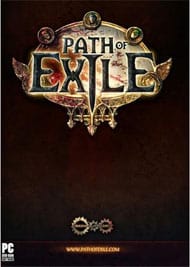On The Path To Greatness
Path of Exile may be the rarest of titles, one that provides ample innovation while still honoring the tradition from which it hails. On the surface, it’s naught but a run-of-the-mill point-and-click action-RPG. A Diablo clone, to use the outdated colloquialism. Beneath the surface, though, beats a heart that is both beautifully streamlined and almost endlessly deep, all coalescing about an intuitive core.
The action begins after you choose one of six classes, which initially appear to conform to the playstyles you’d expect, a range that includes stealth and magic along with brute force. This will prove both true and inaccurate in turn. Your chosen character, exiled from his or her homeland for an appropriate crime, washes up on the shore of Wraeclast, the pestilence-ridden, monster-infested land to which prisoners and apostates are banished and confined. Here, you begin in solitary, slaying the risen dead and projectile-spewing insects, defeating a hulking behemoth to gain entry to the game’s first town and social hub.
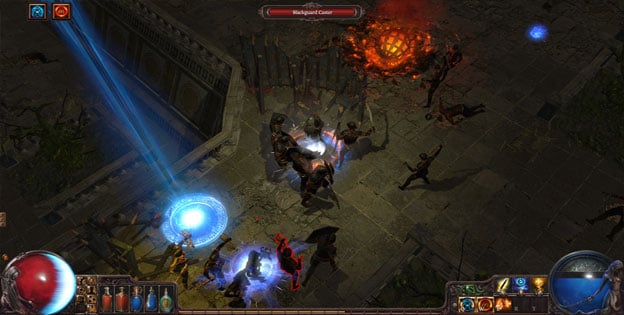
Here, in Lioneye’s Watch, you’ll receive your first quests from NPCs, meet other players, and learn about the skill and trading systems.
Skills are represented by colored gems—red, green, and blue—which can be slotted into weapons and armor to bestow their associated abilities on the player. Red gems tend to be direct, weapon-based strikes, while green evokes the dexterity stat and draws upon ranged abilities and dual-weapon attacks. Blue is where the bulk of the game’s magic is contained, consisting of primarily elemental abilities that tend to require a high intelligence stat to properly utilize. Often, these gems will have a basic stat requirement and/or a level requirement, though some demand the player use specific weapon types.
Abilities level as long as their gems are equipped, whether or not the player is making use of them, and as they level they become more effective, but also present steeper requirements to use. It is entirely possible for a gem to “outlevel” the character who’s using it. Picking equipment becomes not merely a matter of stats, but of what slots that equipment possesses. This is especially important when Support gems come into play, since they also come in all three colors, but only affect the abilities of gems to which they are “linked,” demanding further specialized equipment.
If all of this sounds confusing, it’s only because of the abstraction of description. In practice, it all makes terrific sense, especially since gems can be removed from equipment and re-slotted with no penalty whatsoever, at any time. Which item they’re equipped in doesn’t seem to affect matters either, characters gaining the same benefit whether Leap Slam is slotted in a sword or the helmet.
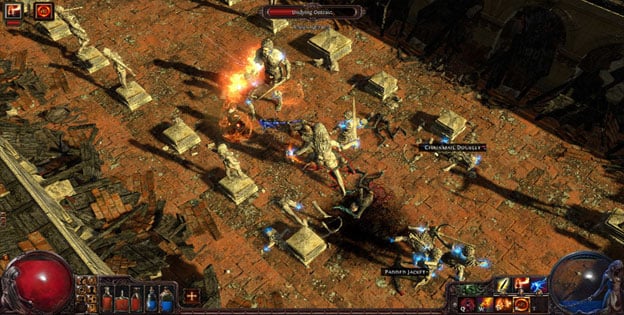
Equipment, too, is varied, and the benefits parallel one another nicely, providing mechanical differences rather than merely varying degrees of effect. It’s possible to armor oneself, mitigating incoming damage, or eschew armor for evasion, such that one takes damage less frequently. Maybe your character is focused on possessing and buffing an energy shield, essentially extra hit points that rapidly recharge on their own and provide an initial layer of defense.
The items you find are also part of the trading system, which is truly that. There is no standard currency in Path of Exile. No gold coins, gil, doubloons, or credits that can be used universally to field all purchases. Instead, trading items to NPCs begets scraps of scrolls and shards of gems, which are directly useful in identifying magic items or buffing your equipment. When purchasing equipment and items from traders, the prices are given in appropriate items for trade. Perhaps that sword you’re eying will run you three Scrolls of Wisdom. It makes transactions a more guarded thing, and provides less pressure for the player to pick up every item, or even every magic item, they come across.
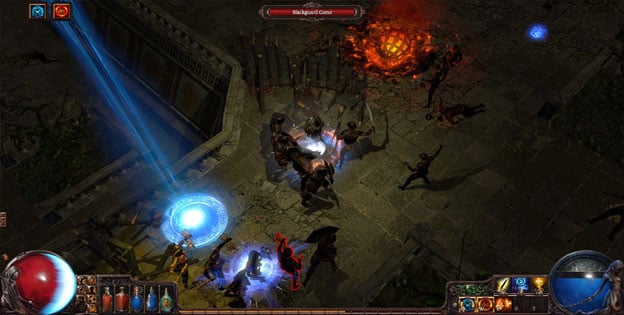
This unconventional approach is also touched on in the combat. While, mechanically, it all feels very familiar, with basic attack on left click and special attacks on the right and middle mouse buttons, there is also a hotbar beneath that, which corresponds to the Q, W, E, R, and T keys. It’s fully possible, and even likely, that you will not fill out this hotbar for a long time, if ever. It’s constantly in flux with you swapping out equipment and ability gems.
More important is that mana recharges fairly quickly, but health does not recharge without specific equipment. This is mitigated by one of the most brilliant touches in Path of Exile: one’s potions, quickslotted to the 1-5 keys, regain “charges” by way of combat, refilling as you kill enemies or when special conditions associated with unique flasks are met. This completely nullifies potion hoarding, since only the flasks in your belt actually fill, losing their charges as soon as they’re removed. Given that some even provide additional benefits upon use, potions are quaffed freely in Path of Exile, making them part of the regular balance of combat rather than a hallmark of paranoid preparation.
That isn’t to say that Path of Exile is a forgiving game. It is relentlessly and intentionally difficult, demanding situational awareness and judicious use of mana and potions to make it through enemy hordes. Even the Marauder, the game’s big-and-strong class, can’t just wade into the throng and go nuts. He’ll quickly be overrun. He must use his abilities in an appropriate, effective manner, maximizing the damage he does while avoiding taking excessive damage himself.
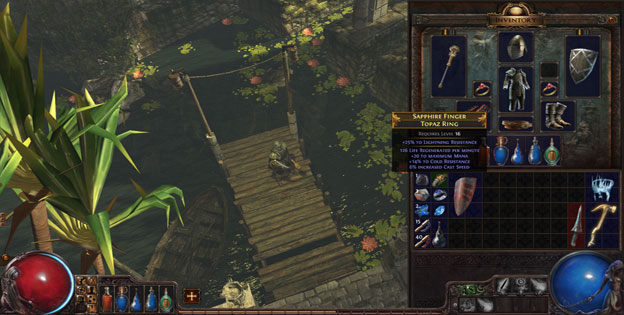
The passive skill tree also follows this philosophy. It is a sprawling map reminiscent of the sphere grid of Final Fantasy X, allowing progress to any node as long as you have chosen a single linked one. The buffs it provides to your character, both specialized and general, are permanent, and every class shares the same grid. They do, however, begin at different points around it, minimizing overlap. That said, there’s nothing stopping one class from putting the bulk of their points into another class’ “area,” but it pays to be careful. There’s no such thing as a full respec (intentionally so, according to the developers), with respec points handed out sparingly, and only affecting the last few nodes one has selected.
And the aesthetic, as well, fits the harsh tone of the gameplay. This is a place of exile, a dark fantasy wasteland with survivors of questionable integrity working in their own interests, often at odds with one another. While the visuals in the earliest areas are fairly mundane and unexciting, the effects conjured in even the mid-point and tail end of the first act are often stunning. Overall, it bears more than a passing resemblance to Dark Souls in tone and texture, if not in gameplay. The sound design is effective, with strikes in combat sounding satisfying and meaty. The voice acting, too, is well done. It could use some more visual variety among its enemies, with a lot of reskins and recolors, but that is a fairly minor complaint, and one certainly capable of being addressed.
Path of Exile is free-to-play, and is supported by microtransactions, but these are all tangential to the actual gameplay. They provide additional account features, such as bonus character slots and customizable stash tabs, or cosmetic changes to abilities and items. Nothing appears to directly affect gameplay, except perhaps the “custom content” item, which allows a player to help design and introduce a unique item to the game. It also costs $1,000, far outside the range of most purchases for the title.
Path of Exile is a surprise. It’s addictive and wonderful, hitting on the best notes of action-RPGs of days gone by while providing a mature and enticing world (though its story is a bit thin), challenging combat, and some unique and innovative mechanics. It’s also currently in open beta, meaning it’s open for anyone and everyone to play to their hearts’ content.
 By
By
Shelby Reiches
Contributing Writer
Date: February 15, 2013
Game Features:
